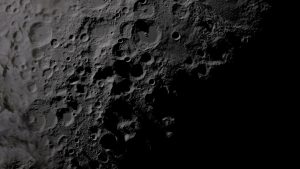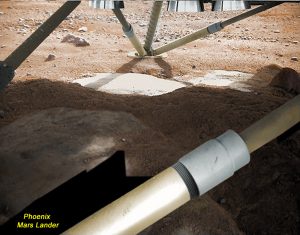A couple of quick notes from Dr. Pamela
We’re going to be taking next Mon-Wed-Fri off streaming the Daily Space while we take time to do some needed maintenance behind the scenes. There will still be stuff going on, and when I can, I’ll share it all with you! On Tuesday we’ll have a normal episode with guest Jian-Yang Li to talk about Comet Borisov, and Catherine Johnson will join us on Thursday to talk about Mars’ Magnetic Field.
Media
Transcript
As we enter day quitzillillion of sheltering in place, today seems like a good day to discuss death and destruction. Our universe is after all trying to kill us, and some days that seems more apparent than others.
Take the moon for instance. This nice big rock in the sky is thought to have been formed when a Mars-sized object hit a trying-to-become-Earth object. This messy collision led to a splash of a lot of the lighter density materials and the merger of the higher density cores. Our system, with Earth’s thin crust and large core and our oddly low-density moon, is the result. Born out of destruction, the Moon has experienced 4.5 billion years of battering as asteroids, comets, and all manner of objects great and small have continually collided with its surface.

NASA/Goddard Space Flight Centre Scientific Visualization Studio
These impacts haven’t just shaped the cratered surface of the moon, they have also impacted what minerals have formed. In a new work from the Royal Ontario Museum, planetary scientists have found evidence of cubic zirconia embedded in a moon rock. This mineral is often used as an alternative to diamonds in jewelry and is formed in hot dense environments that exist either in labs or in the melting outer layers of worlds being impacted. Since jewelry makers aren’t on the moon making these gems, well… we know something horrible happened in the past.
This particular rock was picked up during the Apollo 17 mission in 1972 and was protected for future study. It was hoped that as technology advanced, we’d gain new abilities to learn from these precious rocks. In setting aside these rocks, NASA acknowledged we might not be going back to those places anytime soon, although I’d like to believe they assumed we’d be going back to other places to get other rocks. Today, we do, at least, have better technology. This work, published in a new paper in the journal Nature Astronomy, describes how a team used modern microscopes to scan the minerals. Now, earlier I said they found evidence of cubic zirconia. What they actually found are baddeleyite crystals that formed 4.3 billion years ago from the decay of cubic zirconia that formed in the heat – the 2300 deg C heat of an impact. While we can see craters and get a sense of the forces needed to excavate these large hollows on the moon, these microscopic minerals give us precise temperature limits – it was 2300 deg C or hotter. These rock melting temperatures would have driven mixing of inner and outer layers of lunar crust, producing the complex array of rocks we see today.
One of the reasons we study the moon is so we can get a better understanding of what happened on our own Earth. The mineral record here is much more confusing due to plate tectonics, weather and other effects like volcanoes. As described by lead author Lee White, “Rocks on Earth are constantly being recycled, but the Moon doesn’t exhibit plate tectonics or volcanism, allowing older rocks to be preserved. By studying the Moon, we can better understand the earliest history of our planet. If large, super-heated impacts were creating rocks on the Moon, the same process was probably happening here on Earth”.
So yeah – our world was beat up, too. We’re just better at hiding our scars with a layer of vegetation and erasing them through weather which, after all, can be seen as a form of exfoliation.

CREDIT: Marco Di Lorenzo, Kenneth Kremer,
Phoenix Mission, NASA, JPL, UA, Max Planck Inst., Spaceflight
These collisions in the early solar system are responsible for carrying rock and other material between worlds. We’ve known this for a long time, and it has been speculated that maybe life could be carried between worlds, too, spreading life through a process called panspermia. As we send robot after robot to places like Mars, concerns have arisen that we may be forcing the issue, and our world’s life could contaminate the fragile ecosystem of the Red Planet. In a new paper also appearing in Nature Astronomy, Edgard Rivera-Valentín and company look at the Mars water cycle to determine just how big a problem contamination by earth life could be. According to study co-author Dr Alejamdro Soto, “Our team looked at specific regions on Mars — areas where liquid water temperature and accessibility limits could possibly allow known terrestrial organisms to replicate — to understand if they could be habitable. We used Martian climate information from both atmospheric models and spacecraft measurements. We developed a model to predict where, when and for how long brines are stable on the surface and shallow subsurface of Mars.”
With this model complete, they could then look for the places and times that sufficient moisture exists at or near the surface of Mars to allow extreme life from earth to live. The result was sure… life could exist… but it would die rather quickly. Roughly 40% of Mars’ surface is thought to have liquid water seasonally, but the livable portion of that season is really short … it makes up just 2% of the Martian year. And the conditions aren’t continuous – the liquid exists for up to 6 hours at a time out of the nearly 25 hour long martian day! The team interprets this as meaning that we don’t need to worry about contaminating the martian surface with Earth life while exploring because Mars is fully capable of killing our bugs for us.
As we all learned in Jurassic Park – which admittedly is fiction but still offers some good life lessons – life has a habit of finding a way… but Earth life will face one hell of a challenge finding its way on the Martian Surface.

ESA/XMM-Newton; Radio: NCRA/GMRT
Planets and moons aren’t the only places we see documented destruction in our Universe. In today’s final story, we have new images from the Chandra X-Ray observatory of galaxy clusters that have tried to pass through one another and, in the process, have only torn themselves apart. Roughly four million years ago, two systems of hundreds to thousands of galaxies collided. Since both these systems were mostly empty space, the bulk of the stars and other dense objects passed through each other without experiencing too large an effect, but the intergalactic gas in these systems collided, and gravitational tidal effects rearranged both systems. The resulting carnage glows brightly in X-Ray, where the hot gas in the cores of the two systems shines brightest. A bridge of heated gas connects the cores. This system is collectively called Abell 2394, and while it was discovered decades ago, this research uncovered one surprising new detail. At the outskirts of the smaller of the two sub-clusters, a particularly active galaxy has a particularly active supermassive black hole with jets that are so powerful they are reshaping the bridge of material between the systems. This work is described in a new paper in Monthly Notices of the Royal Astronomical Society that was led by Viral Parekh, and it follows the active galaxy from the X-Ray out to the radio, where it is possible to resolve massive radio lobes pushing out and colliding with the hot X-Ray gas, showing once again that to understand a system, you need to study it in detail using the entirety of the electromagnetic spectrum. In this case, they found one supermassive black hole able to drive the formation of jets that shape a 6 trillion Solar mass bridge of material.
The moral of the news is: something small can have one hell of an impact on the mighty. From asteroid impacts shaping the moon, to cold killing life on Mars, to one SMBH warping a massive galaxy cluster… it’s destruction all the way down. So be careful out there, and remember the Universe is trying to kill you.
Learn More
New evidence shows giant meteorite impacts formed parts of the moon’s crust
- Royal Ontario Museum Press Release
- “Evidence of extensive lunar crust formation in impact melt sheets 4,330 Myr ago,” L.F. White et al., 2020 May 11, Nature Astronomy
Salty Liquids on Mars – Present, but not habitable?
- Lunar and Planetary Institute Press Release
- USRA Press Release
- Southwest Research Institute Press Release
- “Distribution and habitability of (meta)stable brines on present-day Mars,” E.G. Rivera-Valentín et al., 2020 May 11, Nature Astronomy
Abell 2384: Bending the Bridge Between Two Galaxy Clusters
- Chandra X-Ray Observatory article
- “A rare case of FR I interaction with a hot X-ray bridge in the A2384 galaxy cluster,” V. Parekh et al., 2020 January, Monthly Notices of the Royal Astronomical Society (free on arXiv.org)
Credits
Written and Hosted by Pamela Gay
Audio Editing by Pamela Gay, Ally Pelphrey, and Beth Johnson
Video Editing by Tim Hawkins
Intro and Outro music by Kevin MacLeod, https://incompetech.com/music/

 We record most shows live, on Twitch. Follow us today to get alerts when we go live.
We record most shows live, on Twitch. Follow us today to get alerts when we go live.